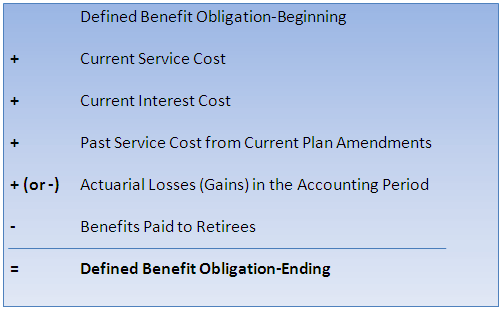Defined Benefit Plans & the Company Balance Sheet
A Net Asset or a Net Liability Exists (unless DBO value = value of Plan Assets)
DBO End of Period
Recall that the defined benefit obligation represents the present value of company retirement compensation promises for vested and un-vested employees, with assumptions for future salary increases (GAAP term is projected benefit obligation).
For accounting purposes, the DBO is liability and should be analyzed as such, but GAAP and IFRS require companies to report net position of the plan’s funded status (which can also be positive and thus an asset for public financial reporting purposes). The funded status is based on the difference between the fair value of plan assets and the DBO.
The ending value for the accounting period’s DBO is outlined below.

Plan Assets End of Period
Plan assets are investments made on behalf of the interests of the pension beneficiaries in order to provide funding of retirement benefits for current and future retirees.
The ending value for the accounting period’s plan assets is outlined below:

Funded Status = FV of Plan Assets - DBO
Net Balance Sheet Asset: FV Plan Assets > DBO
Net Balance Sheet Liability: FV Plan Assets < DBO
When appropriate actuarial assumptions are applied, the funded status represents the net economic position of the pension plan.
Funded Status: IFRS & GAAP
Under both IFRS and GAAP, the net position of the pension is shown on a single side of the balance sheet (either an asset or liability).
It can be argued that separately reporting the plan assets as a standalone asset and the DBO as a standalone liability is more useful for analytical purposes.
There are technical differences between GAAP and IFRS reporting for a defined benefit plan’s funded status and other disclosures and these are attempted to be reconciled as part of the IASB-FASB convergence project.


